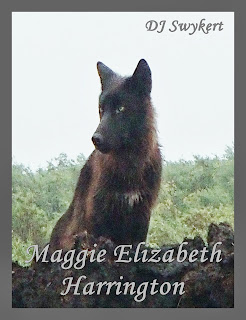Sometimes when writing the lines between reality and
fiction become a bit blurry. I began Maggie Elizabeth Harrington intending to
write a historical story about a lonely woman who loses her mind after being
jilted by her lover. I ended up with a novel about a young woman in a remote
northern Michigan mining town trying to save a pack of wolves from a bounty
hunter. It wasn’t difficult to figure out how the transition occurred. I had
agreed to watch a pair of arctic hybrids for a friend and soon found myself
attached to the ten week old hybrid wolf pups and fascinated by their
behaviors. My reality became my fiction. Maggie would be someone who would want
to protect these beautiful animals from bounty hunters. The story of Maggie
Harrington and her wolves unfolded almost as if it were writing itself and the
farther it progressed the further my interest in wolves increased.
This led me to do some research on wolves, including
the studies by a professor at Michigan Technological University, Rolf Peterson,
who has written on the wolves of Isle Royale for thirty years. Here is a brief
history of Michigan wolves. There was a time when there were abundant packs. A
bounty existed on them in the early 19th century and into the twentieth
century, thirty-five dollars for the head of a female, and thirty for a male.
The population was decimated and for most of the second half of the twentieth
century were non-existent in the state. They became protected in 1974, and the
population has increased steadily since. There are about 687 recorded wolves
now that live only in the Upper Peninsula; there are still none in the Lower
Peninsula.
I saw my first wolf in 1994, two of them roadside
near Copper Harbor howling at the Fourth of July fireworks. I have seen perhaps
a half dozen since. They have been removed from the endangered species list,
and managed hunting is currently allowed once again. The relationship between
wolves and human beings is very ancient. We shared similar survival techniques,
living in organized societies for protection and hunting in packs. Rather than
compete for food sources we simply joined forces. I believe this is the origin
of the bond between man and wolf, and now dogs, which are simply domesticated
wolves. The gray wolf, canis lupis, and a domesticated dog, canis lupis
familiaris, share the same DNA profile. You cannot forensically differentiate
one from the other.
Maggie Elizabeth Harrington ultimately became a book
with multilayered themes concerning social and environmental issues. I see the
book as crossing genres between romance and adventure, and landing somewhere in
a gray area between YA and Literary. The narrator is thirteen, but I believe her
ideas are adult enough to engage literary readers.
Since writing this book, I have come to three significant
conclusions about wolves: they work together, mate for life and protect their
young. They have a loyalty within the pack hierarchy that is beyond ours. There
is no divorce in a wolf pack. Only the alphas mate, but they mate for life. If
one of the pair is killed, the next highest ranking wolf in the pack, a beta,
takes its place. They protect their young, whether it’s the alpha parent, a
beta, or the omega wolf; which, although relegated to the bottom of the order
in the pack, does participate in pack duties, often playing the role of a
babysitter while the rest of the pack hunts. If the human race lived as wolves,
the earth would be a far different place.
I still cherish the memories of stuffing both of the
150 pound wolf hybrids into my Jeep Wrangler and doing some traveling. From the
time I wrote the book until I moved to Kentucky, I lived in five different
places, and I hauled and lodged those wolves with me at each one. I’m not sure
I’d want to do that again, but they are fond memories. And what is life but
memories, sweet illusions that move in all directions and linger much longer
than reality. Isn’t life but perception and memories of what we are, and were,
and is there really any difference?
Guest Blogger Bio
DJ
Swykert is a former 911 operator. His work has appeared in The Tampa Review,
Detroit News, Monarch Review, Lunch Ticket, the NewerYork, Zodiac Review,
Barbaric Yawp and Bull. His books include Children of the Enemy, Maggie
Elizabeth Harrington, Alpha Wolves, The Death of Anyone and The Pool Boy’s
Beatitude. You can find him at: www.magicmasterminds.com/djswykert. He is a wolf
expert.
Links to his work:
http://www.melange-books.com/authors/djswykert/deathofanyone.html
http://www.writewordsinc.com/
http://tlblisspress.blogspot.com/p/dj-swykert.html
http://www.melange-books.com/authors/djswykert/deathofanyone.html
http://www.writewordsinc.com/
http://tlblisspress.blogspot.com/p/dj-swykert.html
Books:








Wow! An interesting interview from a fascinating person. Just goes to show how the knowledge gained from our experiences contributes to who we are as authors and what we write about.
ReplyDelete